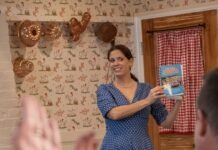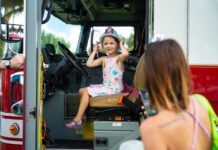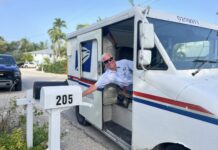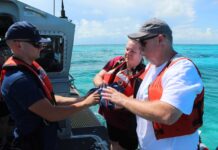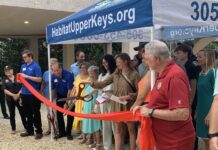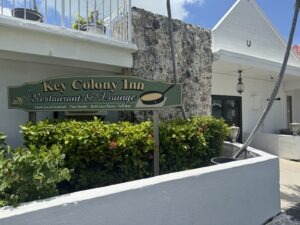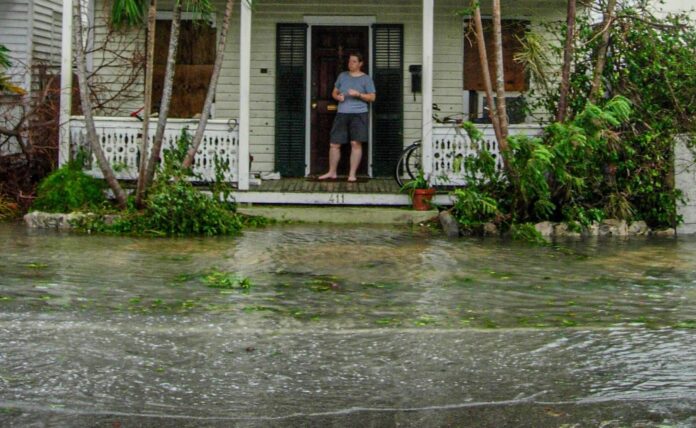
The composition isn’t bad, but the lighting is terrible, meaning the color is also terrible. And there’s a power line going across the top quarter of the photo, some dead branches in the upper left corner, and you can’t see the expression on my wife’s face very well, or the fact that she’s holding a half-eaten Pop-Tart.
Then there’s all that ugly water at the doorstep of our house.
Still, it’s one of my favorite photographs from our marriage.
Years ago, during one of the Keys’ lesser hurricanes, my friend Craig had gone out onto the White Street Pier as the eye passed over to get a little fresh air. It was all pretty calm at first, but then the winds started picking up, and waves started making those big, foamy crashes over the end. People started to panic.
“Run!” someone yelled, “It’s the storm surge!”
And many people did, in fact, begin to run, though not Craig.
Turns out it was the trailing edge of the eye, the beginning of the third act of most hurricanes.
There was a collective idea at the time that storm surges were fast, that there was going to be a wall of water coming at the island. Possibly because this is what happened during the 1935 hurricane, the one that hit Islamorada and killed more than 400 people.
A short time before I’d taken that photo of my wife, I’d gone out onto the front porch and seen water at the intersection of our block, a hundred yards away.
Man, the water came close, I thought.
Twenty minutes later I’d gone back out onto the porch and seen that the water was at our doorstep.
Oh, damn, I thought.
Storm surges can also be slow.
This was during Hurricane Wilma in 2005 – 20 years ago, but a lot of it still feels fresh. It was the fourth hurricane of that year, following the four hurricanes that hit Key West in some fashion in 2004. I’d been hit by a semi truck doing 50 while I was riding my bike a few weeks before, and I was still stiff and bruised and full of staples. Which didn’t make boarding up the house – again – any easier. It had been two years of one damn thing after another.
I don’t remember much about Hurricane Dennis.
I do remember Hurricane Katrina, the second one, because it was going north of the Keys, but then somehow unexpectedly quickly ticked south, dropping a lot of water on us. I was something of a trendsetter on that one, driving our Saturn wagon through a puddle so deep that it sucked a lot of water up into the engine and totaled the car.
(Turns out the air intake was under the engine, as opposed to on top. Which is probably one of the reasons you hardly ever see Saturns on the road anymore.)
We, of course, took a minuscule fraction of the hit New Orleans took.
Hurricane Rita left more fatigue than impression.
Mostly I remember us lying in the tiny guest room in the back of the house, the walls and floors moving when the heavy gusts hit.
As Hurricane Wilma sent the slow motion storm surge, my wife and I were frankly kind of over it. It’s a bad idea to get blasé about nature’s fury, but even nature’s fury can get tedious after a while. Nan was an editor at the Citizen at the time and was more concerned about work than the rising tide. I felt I had run out of panic.
Not that we were reckless.
We carried everything we felt was important – art, documents, computers, etc. – up to the second floor. We stacked things that we valued on top of things we valued less. The TV went onto a chair, which was on top of the dining room table. CDs and DVDs were in sloppy piles on top of every available elevated surface we had. We hoped the water didn’t get that high, but I remember looking at shelves that contained two rows of my vinyl and thinking, I can let all that go.
We left our ancient pit bull Stu sleeping in a chair.
(He could swim, and knew how to use the stairs.)
The water was topping the first step when we got into the car. I drove Nan over to the Citizen base camp at the La Concha. One of the out-of-town TV crews tried to tell us we couldn’t park there, and Nan was maybe a little less sanguine than I thought, because my normally militantly non-confrontational wife said,
“I’m a journalist, I live here, and my house is flooding. Heck off.”
Only she didn’t say heck.
The water was topping the second step when I got back to the house.
Stu was still asleep in his chair. He was old enough that he had lost most of his hearing at that point. A couple storms before we’d come back into the house and Nan had poked him, and he’d jolted awake, spun around, and had his mouth on her arm before he realized it was her. Then he conveyed the idea of, “Oh my Lord, sorry, I didn’t know it was you,” as clearly as a dog could.
Which was why I poked him with an umbrella to wake him up this time.
We sat on the couch together, waiting to see what was going to happen.
It was a seven-foot storm surge.
The elevation of our house was apparently seven feet, three inches, because the water lapped at the joists and the underside of our floorboards, but then went down.
A few hours later Eaton Street was still flooded.
I thought about wearing my shrimper boots, but no doubt the water would just top over them.
A few blocks later I heard someone asking for help.
It was a woman not in much danger, but stuck behind her gate because the wood had swollen. I went back to the house, got a drill, and another neighbor and I took the hinges off so she could get out.
The storm surge killed off our key lime tree and our mango tree, and I spent a week or two crawling around under the house, in the land of scorpions and broken glass, repairing all the wiring that had been flooded.
But we were so lucky.
People in other neighborhoods had had it far worse.
So many houses flooded. People lost everything. Mold grew everywhere. Hundreds of houses had to be gutted. You heard stories about people having to climb out their window and up onto the roof to escape the surge. And of cars whose horns started honking and windows started randomly going up and down due to short circuiting electrical systems. There were also a lot of stories of insurance companies screwing people over.
For weeks afterward, the sidewalks were lined with damp couches and other furniture.
Almost half the traffic on U.S. 1 looked to be flatbeds hauling two or three totaled cars out at a time.
Some people left town.
Most people rebuilt, brought order back to their life, found a way to move on, let the memory recede like an even slower storm surge.
Nan and I got so lucky.
I doubt we will ever not appreciate that fact.
